Unveiling Argentina’s Architectural Gems: A Journey Through Buenos Aires’ Iconic Buildings and Styles
Step onto the vibrant streets of Argentina, and you might feel transported across continents in a single glance. One moment, you’re enveloped by the classical elegance reminiscent of Paris; the next, you’re struck by a colorful, bustling energy that could be Madrid. This delightful architectural blend is precisely what makes Argentina, and particularly its capital, Buenos Aires, an extraordinary destination for anyone fascinated by design, history, and culture. The city’s buildings are not merely structures of brick and mortar; they are storytellers, each facade and corner whispering tales of the past, present, and the nation’s enduring spirit.
This comprehensive guide invites you on an immersive journey through the diverse architectural landscape of Buenos Aires. We’ll explore everything from the enduring Spanish Colonial structures that laid the city’s foundations to the ornate Beaux-Arts palaces that reflect a period of immense prosperity, and finally, to the innovative modern designs that boldly push the boundaries of contemporary urban living. Prepare to discover enchanting, colorful neighborhoods, marvel at European-inspired landmarks, witness buildings steeped in national pride, and admire cutting-edge modern structures. Argentina’s streets truly are open-air museums, and by the end of this exploration, you’ll understand why Buenos Aires stands out as an architectural wonder like nowhere else on earth.
The Enduring Narrative: A History of Buildings in Argentina
Argentina’s architectural evolution is a profound reflection of its dynamic history, marked by periods of colonization, immigration, economic booms, and profound social change. Each era has left an indelible mark, transforming the urban fabric and creating a fascinating mosaic of styles that capture the nation’s journey through time, from its nascent colonial settlements to its bustling modern metropolis.
Colonial Period (1500s–1800s): Foundations of a Nation
When Spanish settlers arrived in what is now Argentina, they began to systematically transform the landscape, laying the groundwork for future cities. Their early architectural endeavors were driven by practical needs: creating defensive structures and functional settlements in a new environment. Adobe, readily available and excellent for insulation against extreme temperatures, became the primary building material. Settlers constructed simple yet sturdy buildings, often featuring thick walls, small windows to regulate heat, and central courtyards—a traditional Spanish design element that provided privacy, natural light, and ventilation. Churches and government structures were strategically placed as centerpieces of newly formed towns, signaling the dominance of both religious and civil authority. This period saw a distinct blend of European design principles with local building techniques and materials, establishing the first unique architectural identity of the region.
European Influence (1800s–1900s): A Flourishing Grandeur
As Argentina gained independence and experienced significant economic growth, particularly through agricultural exports, a new wave of European immigrants and ideas swept across the country. This influx profoundly shaped Argentina’s architectural landscape, especially in major cities like Buenos Aires. French, Italian, and British influences became highly prominent, leading to the adoption of styles such as Neoclassical, Art Nouveau, and Beaux-Arts. Wealthy families and burgeoning institutions commissioned grand buildings, often designed by European architects or Argentines trained abroad, mirroring the opulent capitals of Europe. Ornate facades, sophisticated urban planning, and lavish interiors replaced the simpler colonial structures. This era was characterized by an aspiration to showcase the country’s growing economic power, cultural sophistication, and its desire to be seen as a modern, European-aligned nation, earning Buenos Aires the moniker “The Paris of South America.”
Modern & Postmodern Eras (1900s–Today): Innovation and Identity
The 20th century ushered in a new chapter for Argentine architecture, reflecting global trends while striving to maintain a unique local identity. Modernist architects, inspired by movements like the Bauhaus and Le Corbusier, began experimenting with new materials such such as reinforced concrete, steel, and glass. This led to innovative designs focused on functionality, clean lines, and open spaces, departing sharply from the decorative excess of the Belle Époque. Contemporary buildings in Argentina today continue this evolution, mixing functionality with artistic expression, often incorporating sustainable design principles and technological advancements. From Buenos Aires’ sleek skyscrapers and Brutalist cultural centers to avant-garde residential designs in smaller cities, Argentine architecture continues to evolve, telling a compelling story of creativity, adaptation, and a rich cultural tapestry that embraces both its historical roots and its future aspirations.
Colonial-Era Famous Buildings in Argentina: Echoes of the Past
The earliest surviving structures in Argentina are powerful reminders of its Spanish colonial past, offering a tangible link to the nation’s foundational years. These buildings, often made of robust materials, served as centers of administration, religion, and community life, and continue to tell stories of governance, faith, and the initial melding of cultures.
1. Cabildo of Buenos Aires
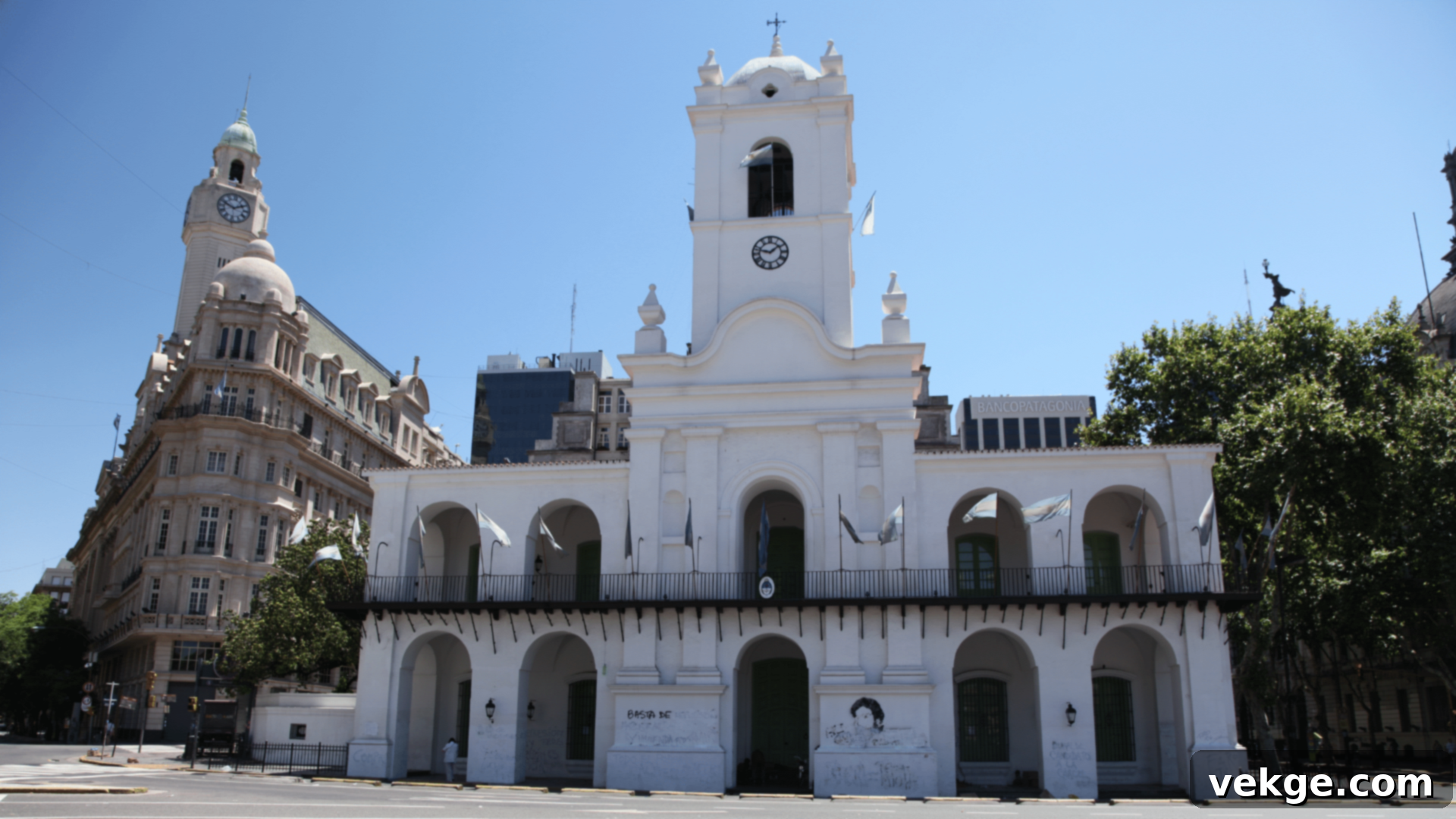
Stepping back in time to the 17th century, the Cabildo of Buenos Aires stands as a profound and enduring symbol of Argentina’s colonial administration. This building was not merely an office; it was the heart of local government during Spanish rule, witnessing pivotal moments that shaped the nation, including the May Revolution of 1810, which marked the first step towards independence. Today, the Cabildo has been meticulously restored to preserve its original beauty and architectural integrity, allowing visitors to experience its spaces almost exactly as they appeared centuries ago. Its classic Spanish colonial style, characterized by a series of arches, a central tower, and simple yet sturdy construction, reflects both its utilitarian purpose and its civic importance.
Beyond its aesthetic appeal, the Cabildo functions as a living museum, housing artifacts and exhibits that narrate the early days of Argentina. Each stone, every wooden balcony, and the preserved interiors tell a compelling tale of the people who inhabited these halls, the decisions made, and the societal shifts that transformed a small colonial outpost into the vibrant metropolis of Buenos Aires. For history enthusiasts and curious travelers alike, the Cabildo offers an invaluable insight into the mechanics of colonial governance, daily life, and the very genesis of Argentine national identity.
2. Casa Rosada (Pink House)
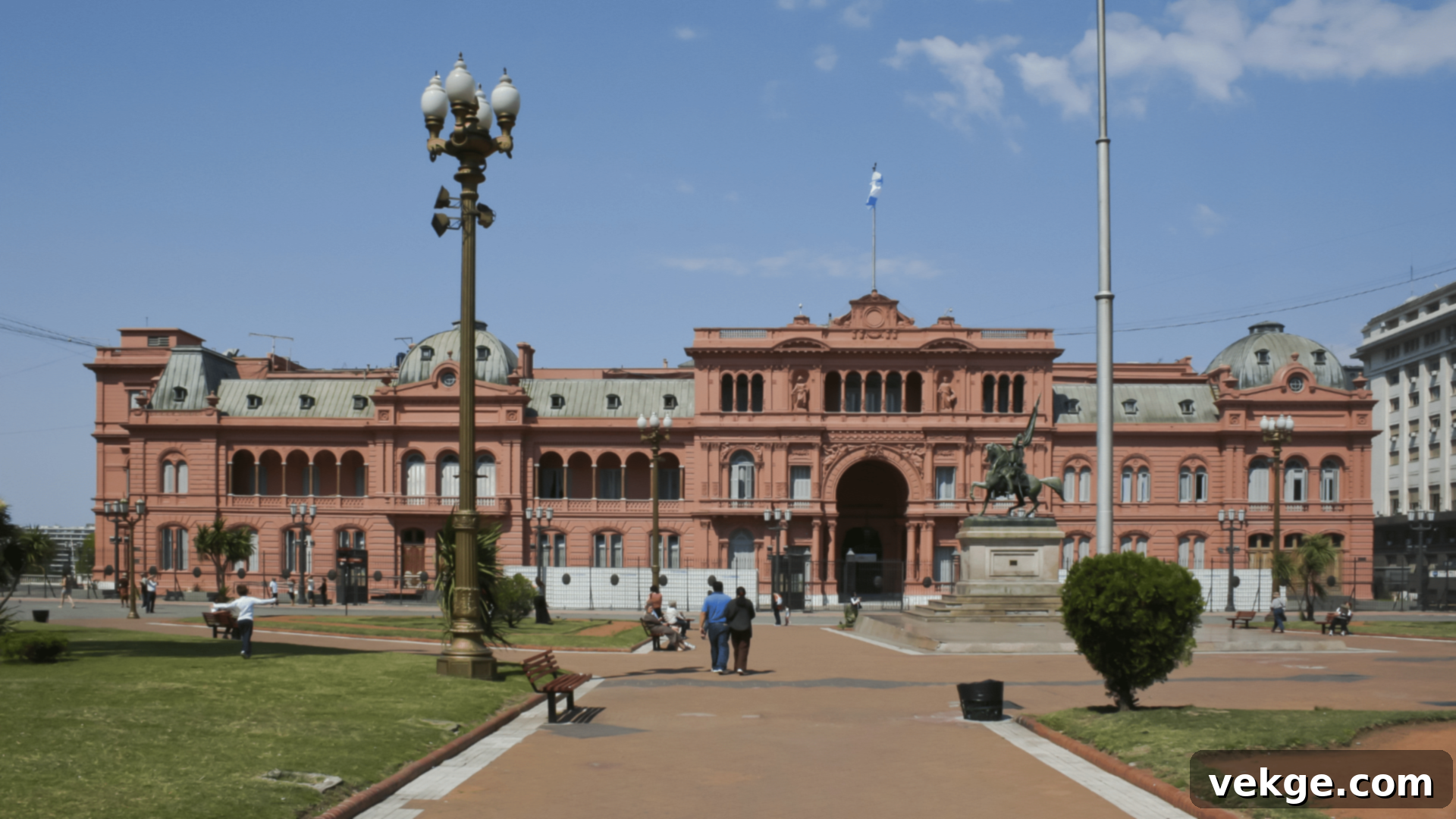
Imagine a building so iconic that its very color encapsulates a significant chapter of political history and national unity. That’s the Casa Rosada, the instantly recognizable pink presidential palace that stands proudly overlooking the Plaza de Mayo in Buenos Aires. Its distinctive pale pink hue is steeped in legend, often attributed to a symbolic compromise in the 19th century: mixing red and white paints, representing the opposing Federalist (red) and Unitarian (white) factions, to signify a peaceful resolution and the unification of the nation. More pragmatically, some historians suggest the color came from adding ox blood to whitewash to protect the building, which was common in the 19th century.
Regardless of its precise origin, the Casa Rosada has served as the ultimate stage for some of Argentina’s most memorable and dramatic moments. Its famous central balcony has been the platform from which numerous presidents and influential figures have addressed the Argentine people, most notably Eva Perón, whose powerful speeches resonated with vast crowds gathered below. When you behold the Casa Rosada, you are observing more than just a magnificent architectural structure; you are witnessing a living monument to Argentine political passion, democratic struggles, and the enduring spirit of its people. Its blend of Italianate and French Second Empire styles further accentuates its grandeur, making it a powerful symbol of state.
3. San Ignacio Miní
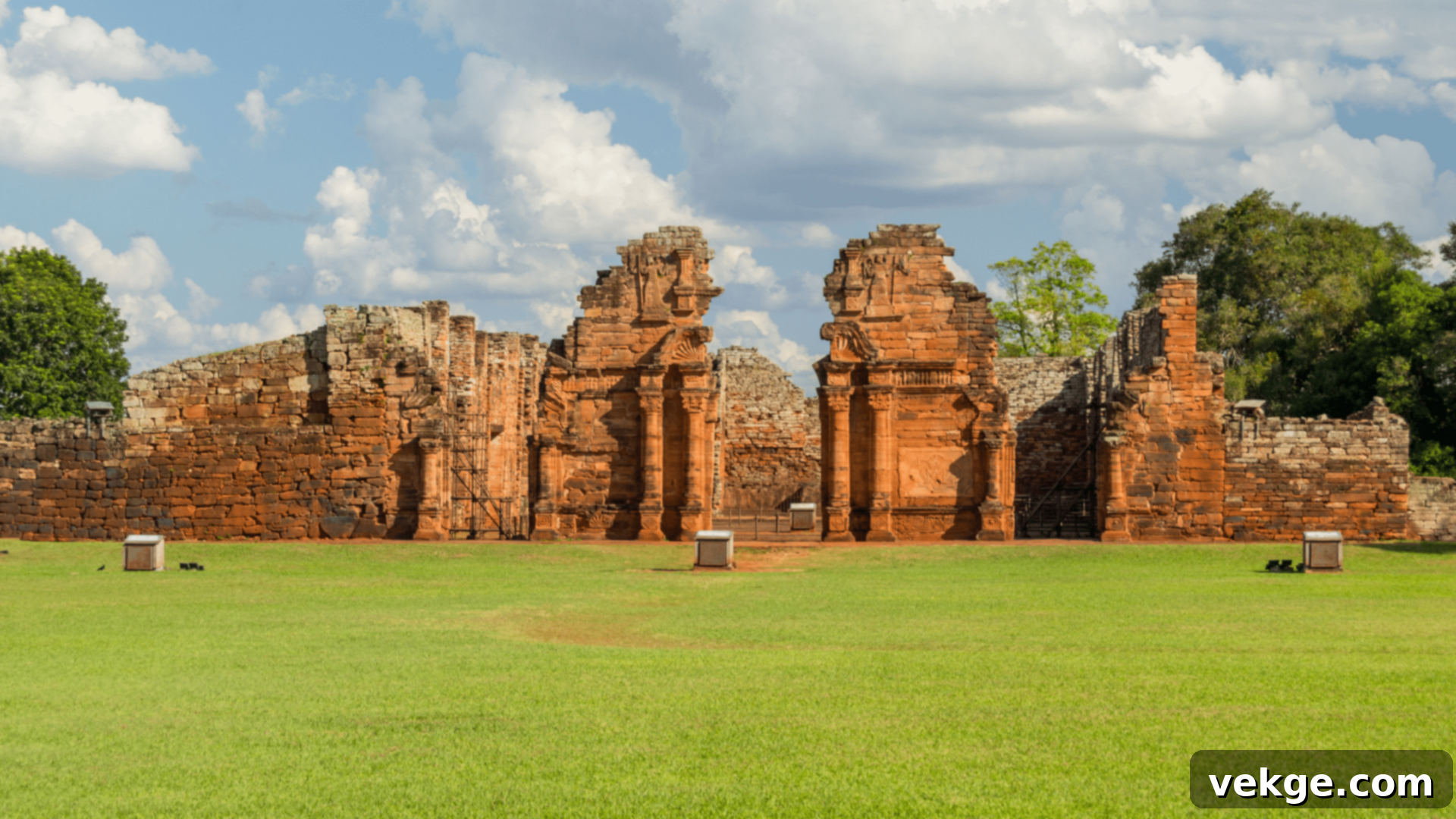
Tucked away amidst the lush, subtropical landscapes of the Misiones Province, San Ignacio Miní stands as a profound testament to Argentina’s complex and fascinating colonial history. This UNESCO World Heritage site represents one of the most well-preserved and impressive remnants of the Jesuit Reductions, a series of missions established in the 17th and 18th centuries by Jesuit missionaries to evangelize and protect the indigenous Guaraní people. The ruins showcase remarkable red sandstone architecture, which appears to organically emerge from the verdant surroundings, creating a striking visual harmony with nature.
San Ignacio Miní is a powerful symbol of the intensive cultural exchanges and often challenging interactions that shaped Argentina. Its distinctive Baroque style, adapted to local materials and techniques, speaks volumes about a period of immense change, where European religious zeal met indigenous traditions, leading to a unique synthesis of cultures. The elaborate carvings, grand church facade, and structured plaza offer a glimpse into the sophisticated society that thrived here. Visitors today can walk among these ancient stones, touching the very structures that witnessed centuries of human stories—of faith, community, forced labor, and the ultimate dispersal of the Jesuit order—offering a truly evocative and educational experience.
19th Century Iconic Buildings of Argentina: National Pride and European Elegance
The 19th century was a period of consolidation and burgeoning national identity for Argentina. Its architecture from this era vividly reflects a growing sense of pride, an increasing cultural transformation, and an embrace of European architectural brilliance, particularly in its grand public and religious structures. These iconic buildings continue to capture the imagination of locals and visitors alike, standing as enduring monuments to a nation coming into its own.
4. Buenos Aires Metropolitan Cathedral
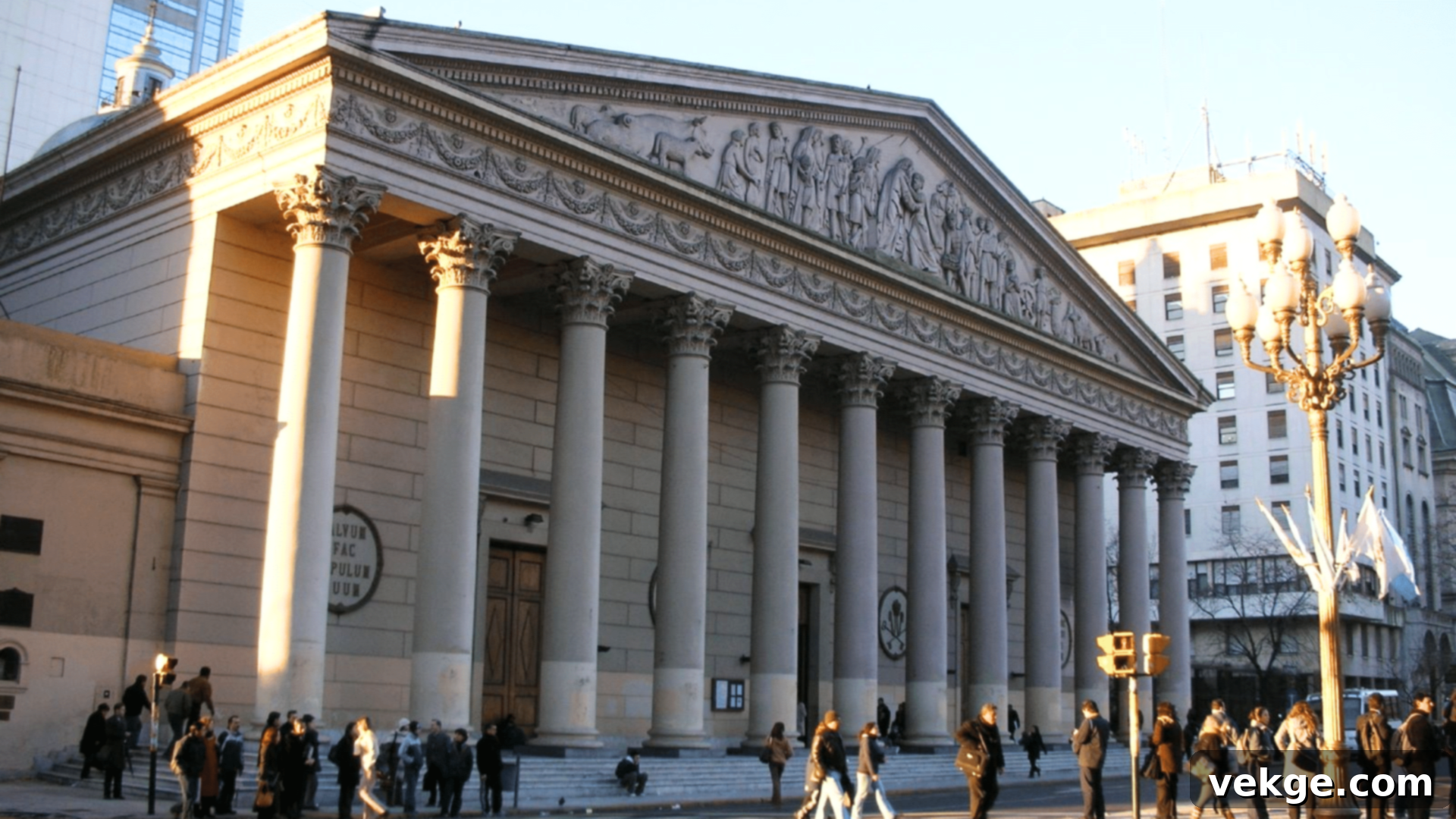
Dominating one side of the historic Plaza de Mayo in Buenos Aires, the Metropolitan Cathedral is far more than just a place of worship; it’s a profound blend of national identity and spiritual significance. Its most striking feature is its grand Neoclassical facade, resembling a Roman temple with twelve Corinthian columns supporting a triangular pediment—a design that sets it apart from many other cathedrals globally. This exterior hints at a rich history that dates back to the early days of the city, though the current structure underwent significant reconstruction over centuries.
Inside, the cathedral offers a breathtaking contrast, with lavish Baroque and Renaissance elements creating a richly decorated space. It houses the magnificent mausoleum of General José de San Martín, Argentina’s revered national hero, whose eternal flame burns as a symbol of his enduring legacy. The cathedral also holds a special connection to the modern era, as it was the archiepiscopal seat of Jorge Mario Bergoglio before he became Pope Francis. This deeply revered institution serves as a powerful symbol for Catholics and non-Catholics alike, representing not just faith, but also the deep historical roots and patriotic spirit of the Argentine nation.
5. Palace of the Argentine National Congress
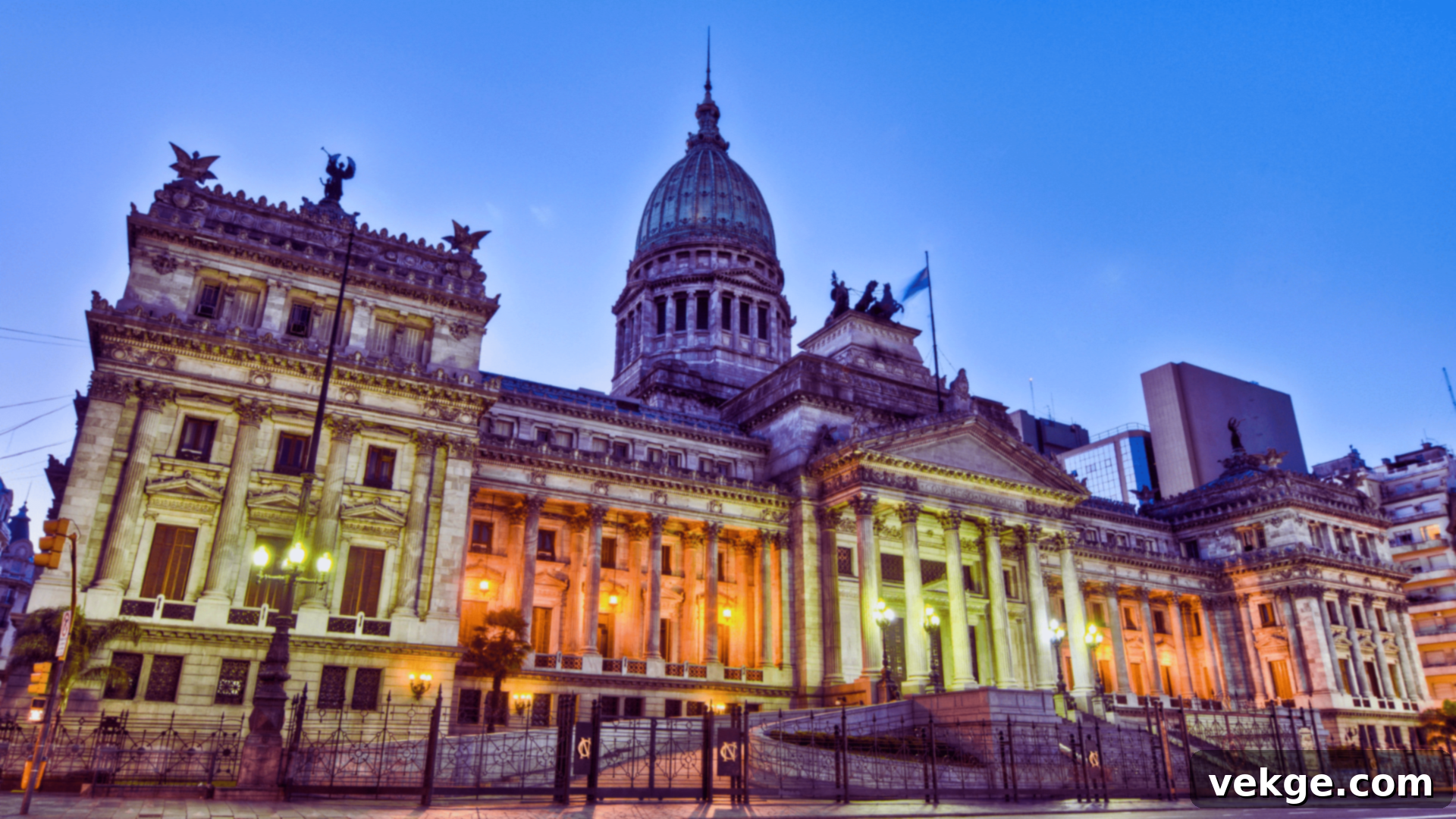
Approaching the Palace of the Argentine National Congress is an experience in itself, reminiscent of walking up the grand steps of the U.S. Capitol or the Reichstag. This monumental building, a masterpiece of Neoclassical and Beaux-Arts architecture, powerfully showcases Argentina’s commitment to democratic ideals and its burgeoning political strength at the turn of the 20th century. Its most prominent feature is the impressive bronze-crowned dome, rising majestically over the city and serving as a beacon of national governance.
Completed in 1906, the palace’s design is replete with allegorical sculptures, grand columns, and intricate detailing, all conveying a sense of stability, power, and the nation’s aspirations. The interior halls are equally opulent, adorned with marble, murals, and detailed woodwork, reflecting the importance of the legislative process that unfolds within. Each column and arch, every carefully crafted detail, tells a story of the country’s political landscape, its constitutional principles, and the ambitious architectural vision of a nation eager to assert its place on the global stage. It stands as a vital symbol of Argentina’s republican institutions and democratic history.
Early 20th Century Argentinian Landmarks: A Golden Age of Design
The early 1900s marked a golden age for architecture in Buenos Aires, a period when the city truly flourished and solidified its reputation as the “Paris of South America.” These magnificent buildings serve as captivating time capsules, showcasing an era of immense creativity, ambitious vision, and profound cultural richness. Each landmark from this period tells a unique and elaborate story of Argentina’s architectural and cultural growth, reflecting both a global outlook and a distinctly national character.
6. Teatro Colón
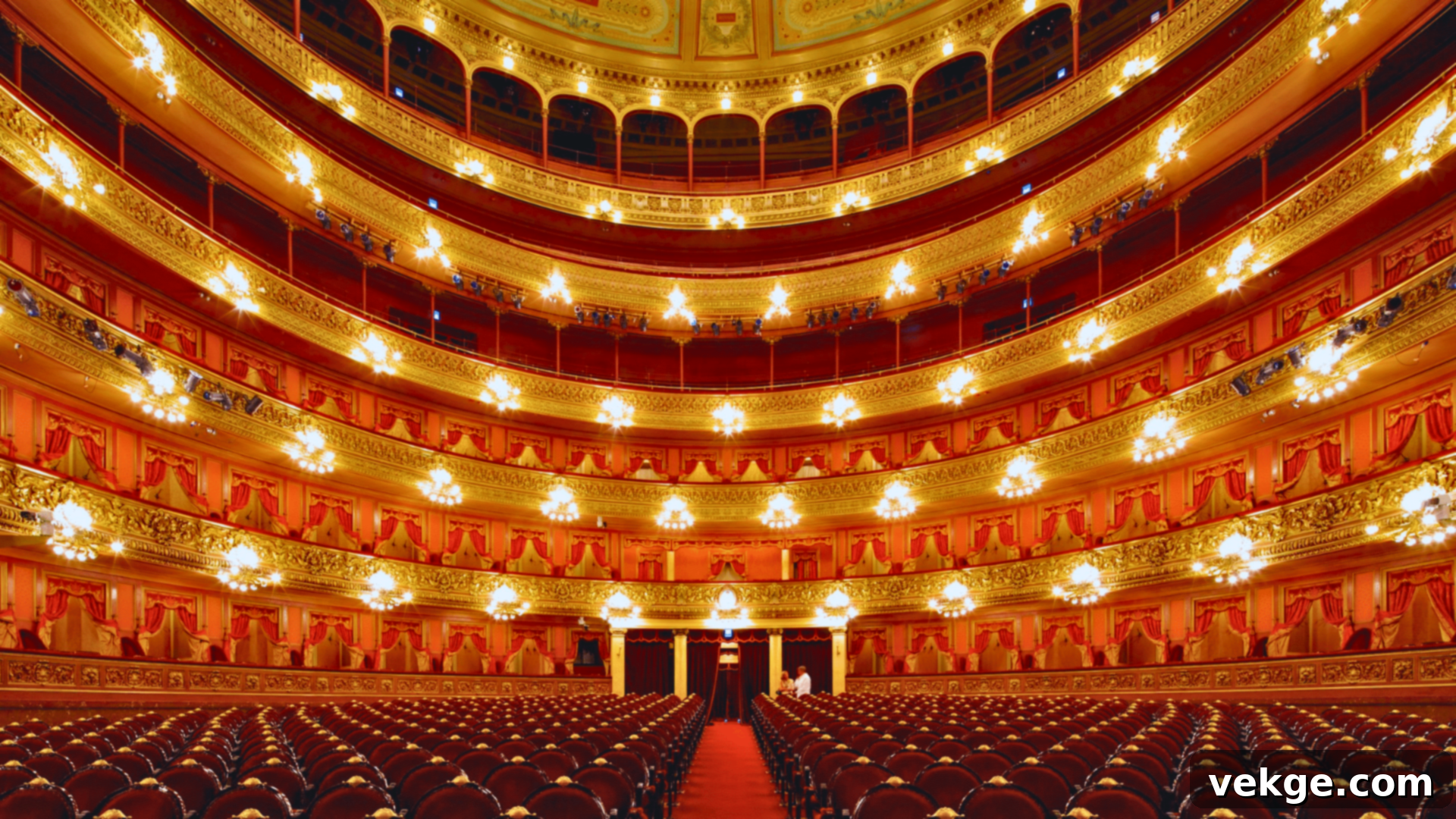
Have you ever stepped into a building that immediately leaves you breathless, utterly mesmerized by its sheer grandeur and artistic brilliance? The Teatro Colón is precisely that kind of place. Revered as one of the world’s top opera houses, this architectural masterpiece stands as undeniable proof of Argentina’s rich cultural background and its deep appreciation for the performing arts. Completed in 1908, its design is a seamless fusion of French and Italian Renaissance styles, featuring an incredibly ornate facade and lavish interiors.
The true marvel, however, lies within its amazing seven-tiered auditorium, designed to transport audiences to another world. The acoustics are legendary, often cited among the five best in the world for opera and classical music, a testament to the meticulous planning and innovative engineering of its time. Musicians and opera lovers from around the globe dream of performing or experiencing a show here. Every corner of the Teatro Colón, from its dazzling chandeliers and intricate frescoes to its velvet seating and gilded balconies, whispers stories of legendary performances, artistic brilliance, and the countless cultural luminaries who have graced its stage. It remains a vibrant hub of artistic expression and a jewel in Buenos Aires’ cultural crown.
7. Palacio Barolo
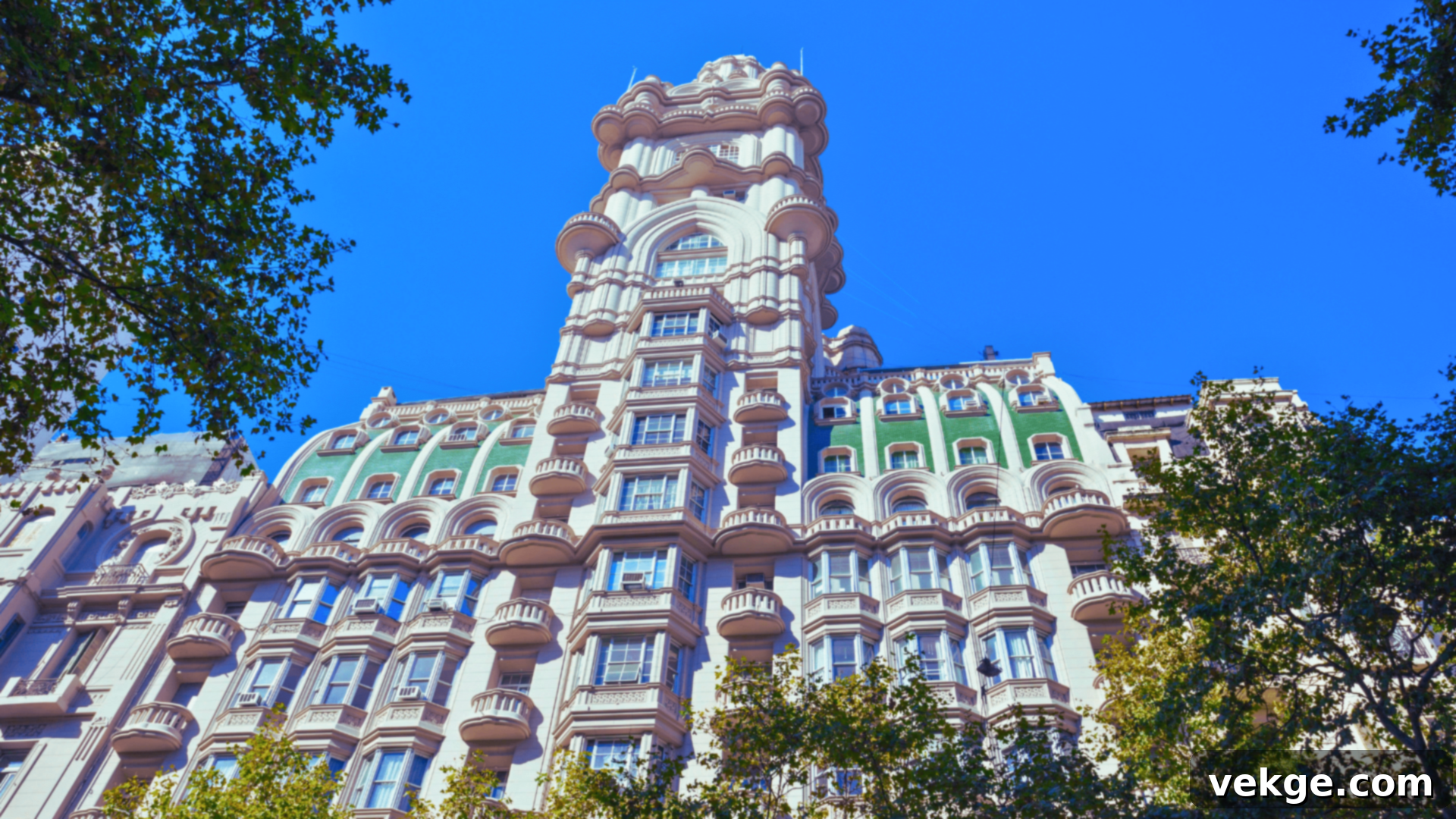
The Palacio Barolo is no ordinary office building; it is a fantastical, allegorical tribute to Dante Alighieri’s epic poem, “The Divine Comedy.” Conceived by Italian architect Mario Palanti and completed in 1923, this skyscraper is a remarkable example of imaginative architecture, blending elements of Gothic, Romanesque, and even Indian styles to create a truly unique structure. Its symbolic tower reaches skyward, with each of its 22 floors representing cantos of Dante’s poem. The building is meticulously divided into three sections: the basement and ground floor representing Hell (Inferno), floors 1-14 representing Purgatory, and floors 15-22 representing Heaven (Paradiso), culminating in a lighthouse at the very top, designed to guide souls.
The Palacio Barolo reflects the profound imagination and cultural depth of early 20th-century Argentine creativity, embodying a period when architecture was seen as a vehicle for grand artistic statements. When you walk through its intricately decorated halls, past its ornate details and into its impressive dome, you are not simply navigating an office space; you are traversing an architect’s deeply personal and profound interpretation of a classic piece of literature, making it a truly unforgettable experience for any visitor.
8. Palacio de Aguas Corrientes (Palace of Running Waters)

Who would ever imagine that a water pumping station could be such a magnificent work of art? The Palacio de Aguas Corrientes stands as a stunning testament to the idea that even the most utilitarian structures can be crafted with incredible attention to detail and a profound focus on beauty. Completed in 1894, this opulent building was designed to house the city’s water purification and pumping machinery, a vital function during a period of rapid urban expansion.
Its striking facade is adorned with an astonishing array of over 300,000 imported glazed terracotta tiles and decorative bricks, predominantly from England and Belgium. These vibrant, colorful tiles, combined with intricate ironwork and sculptural elements, make the building truly stand out in the cityscape, resembling a grand European palace more than a municipal utility. Today, it still houses offices for the national water company and a fascinating museum that chronicles the history of water provision in Buenos Aires. The Palacio de Aguas Corrientes serves as a charming and unexpected example of Argentina’s Belle Époque ambition, demonstrating a time when public infrastructure was treated with the same artistic reverence as grand theaters and private mansions.
9. Paz Palace
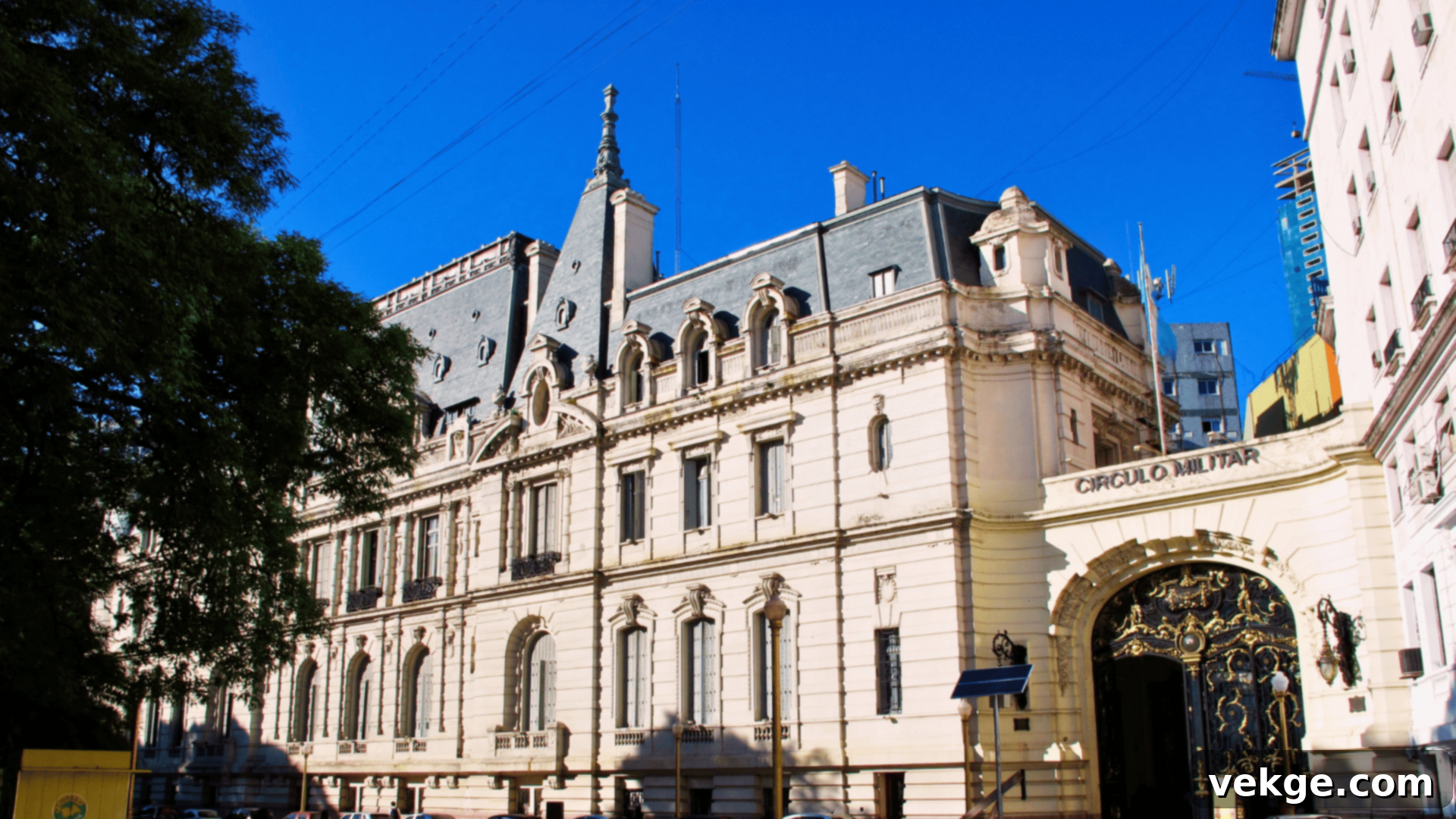
Step into the opulent world of early 20th-century luxury with the Paz Palace, an architectural marvel that unequivocally showcases the peak of Argentina’s Belle Époque prosperity. Built between 1902 and 1914 for José C. Paz, a prominent newspaper magnate, this colossal French Beaux-Arts mansion was, at the time, the largest private residence in Buenos Aires. Its construction was a truly grand undertaking, with virtually all materials—from marble and bronze to intricate woodwork—imported directly from Europe, underscoring the owner’s immense wealth and the nation’s economic might.
The palace features an astounding 140 rooms across 12,000 square meters, including magnificent ballrooms that once echoed with the cheers of lavish celebrations and historic diplomatic moments. Its design is a tribute to French aristocratic residences, complete with grand staircases, elaborate salons, and meticulously landscaped gardens. Today, the Paz Palace serves as the headquarters for the Military Officers’ Association (Círculo Militar) and offers guided tours, allowing visitors to glimpse the extravagant lifestyle of Argentina’s elite during a period of intense cultural and architectural innovation. It stands as a majestic symbol of a bygone era of unparalleled luxury and European influence on Argentine society.
Modern and Contemporary Structures: Visionary Designs of the 20th and 21st Centuries
As Buenos Aires moved into the 20th century, its architectural landscape began to shift dramatically, embracing global trends in modernism and creating a bold new identity. This section highlights some of the most impressive and innovative buildings from the 20th and 21st centuries, showcasing how the city grew and changed, and how its architects mixed art and function in compelling new ways. These structures tell a story of innovation, adaptation, and a confident look towards the future.
10. Kavanagh Building
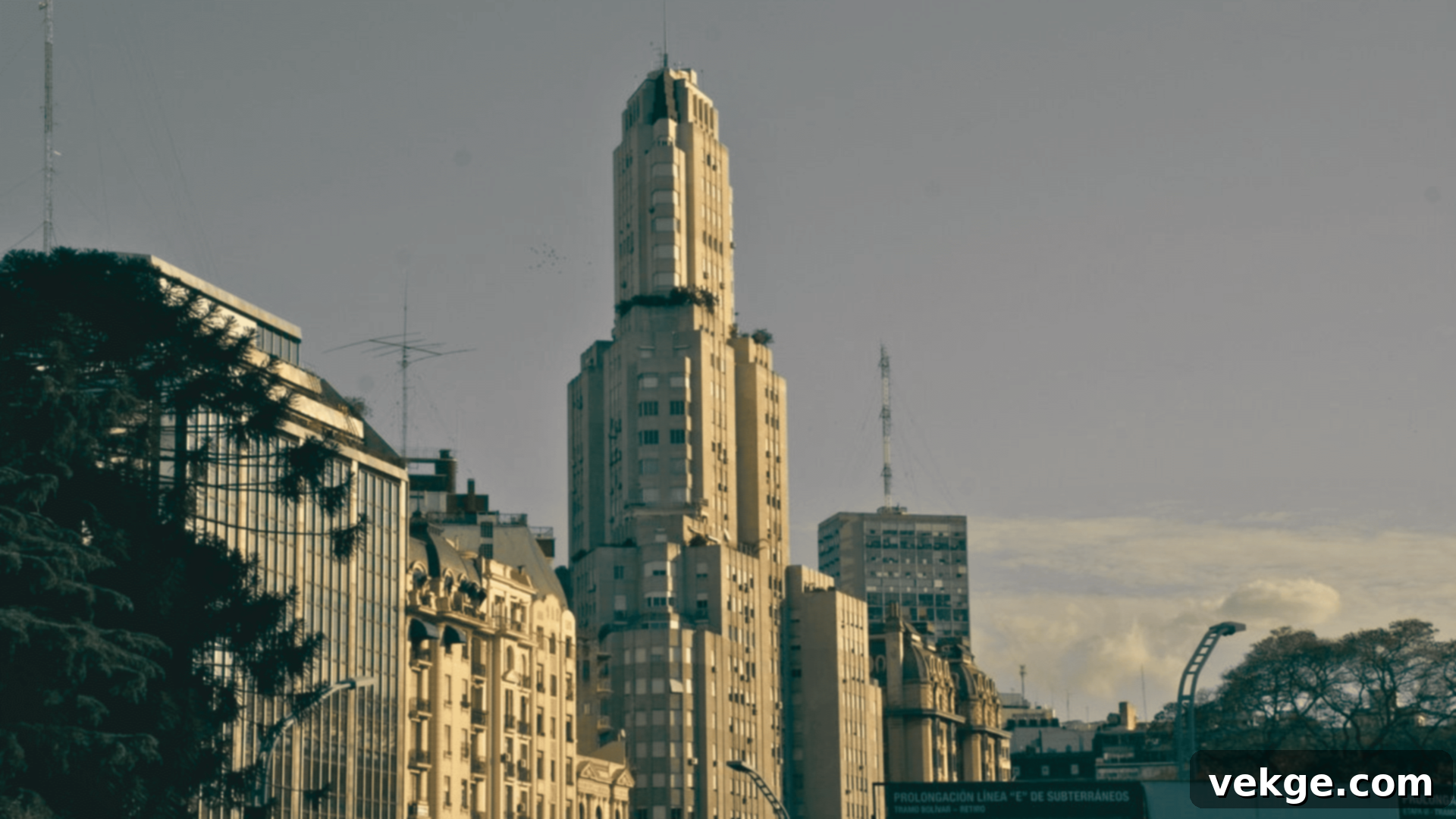
The Kavanagh Building, an iconic Art Deco skyscraper completed in 1936, was a truly revolutionary structure for its time and remains a significant landmark in Buenos Aires. Upon its completion, it held the distinction of being the tallest reinforced concrete building in the world and the tallest skyscraper in Latin America. This monumental achievement showcased the remarkable skill and ambition of Argentine engineers and builders, solidifying the nation’s capacity for modern construction.
Standing majestically at the Plaza San Martín, its distinct stepped outline, clean lines, and geometric patterns are quintessential Art Deco, making it a prominent example of early modern building styles in South America. The building, constructed rapidly in just three years, was commissioned by Corina Kavanagh and was designed without a single elevator shaft directly connecting the ground floor to the owner’s penthouse, a unique and famous detail. When you visit Buenos Aires, its elegant, bold shape continues to stand out against the city sky, symbolizing both architectural innovation and a luxurious urban lifestyle.
11. Torre Monumental (Monumental Tower)

The Torre Monumental, often affectionately called “Buenos Aires’ Big Ben,” possesses a fascinating and somewhat poignant history. Originally known as the “Torre de los Ingleses” (Tower of the English), it was a lavish gift from the local British community to Argentina in 1916, commemorating the centenary of the May Revolution. Its distinctive red brick design, complete with a functional clock and bells, stands in stark contrast to much of the surrounding architecture, evoking a clear sense of British influence and Victorian Gothic style.
However, its name and identity took on a new significance after the Falklands War in the 1980s. In a wave of national sentiment, locals officially changed its name to “Torre Monumental.” Despite the renaming, the clock tower still subtly displays both British and Argentine symbols side by side, serving as a powerful reminder of how historical events, international relations, and political changes can directly impact even the most iconic buildings and their public perception. It’s a compelling architectural landmark that speaks volumes about Argentina’s complex cultural past and its evolving national identity.
12. Villa Ocampo
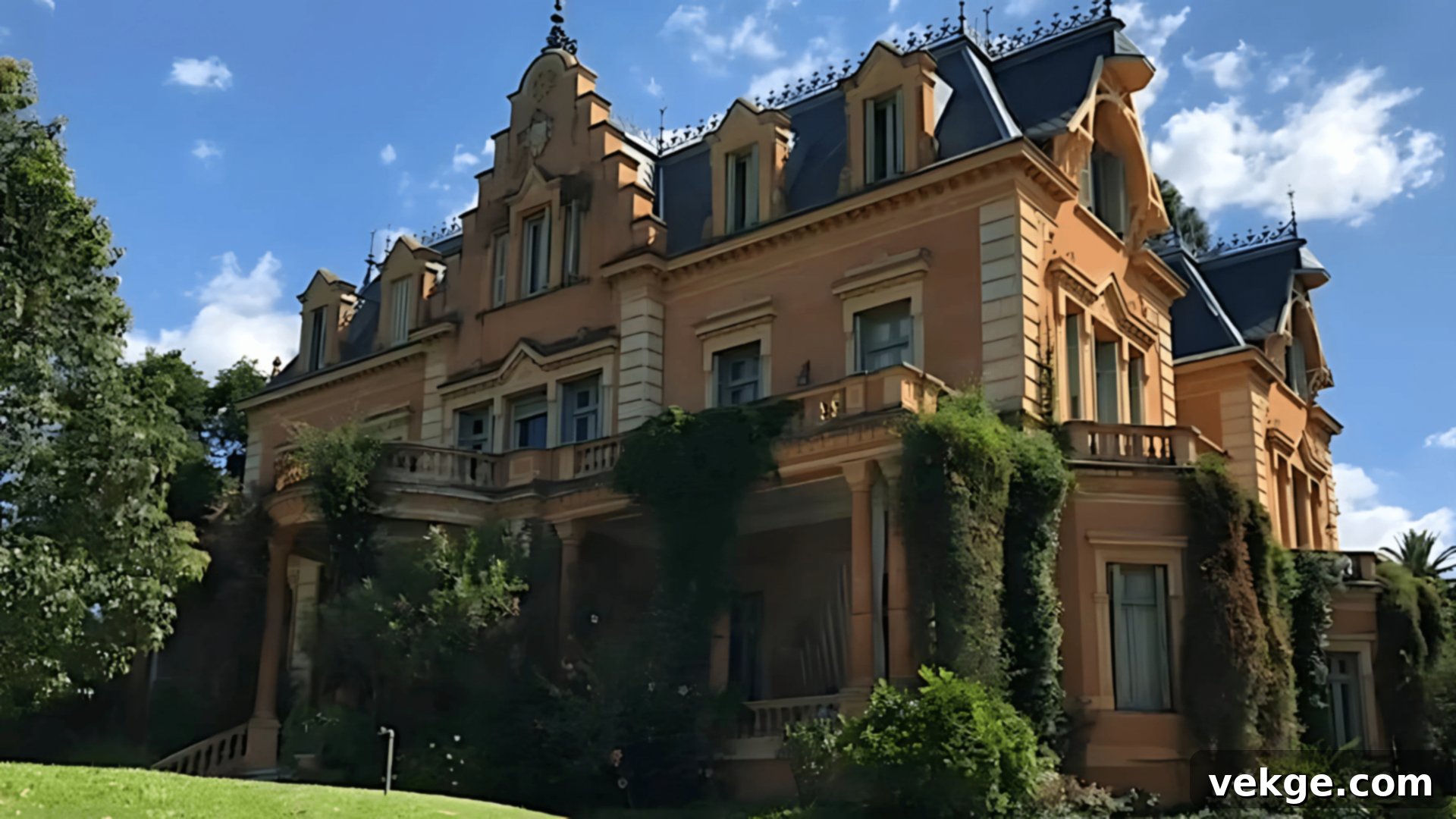
Breaking away from the ornate, European-inspired mansions of its time, Villa Ocampo holds a special place in Argentine architectural history as the first modern-style house in Buenos Aires. This elegant residence was owned and meticulously designed by Victoria Ocampo, an influential Argentine writer, intellectual, and patron of the arts, who drew inspiration directly from the revolutionary ideas of renowned modernist architects like Le Corbusier. Her vision resulted in a structure characterized by clean, simple shapes, open spaces, and a functional aesthetic that was radically different from the elaborate older homes dominating the city’s affluent neighborhoods.
Constructed in the 1920s and renovated with modernist features in the 1930s, Villa Ocampo became a vibrant cultural hub, hosting a who’s who of international literary figures including Igor Stravinsky, Albert Camus, Graham Greene, and Jorge Luis Borges. Today, managed by UNESCO, you can visit this remarkable house to explore how modern architectural principles first took root in Argentine home design. It stands as a powerful testament to how one individual’s progressive vision and influence can catalyze the introduction of new styles and ideas, fundamentally shaping the architectural and cultural landscape of an entire city.
13. Puente de la Mujer (Women’s Bridge)
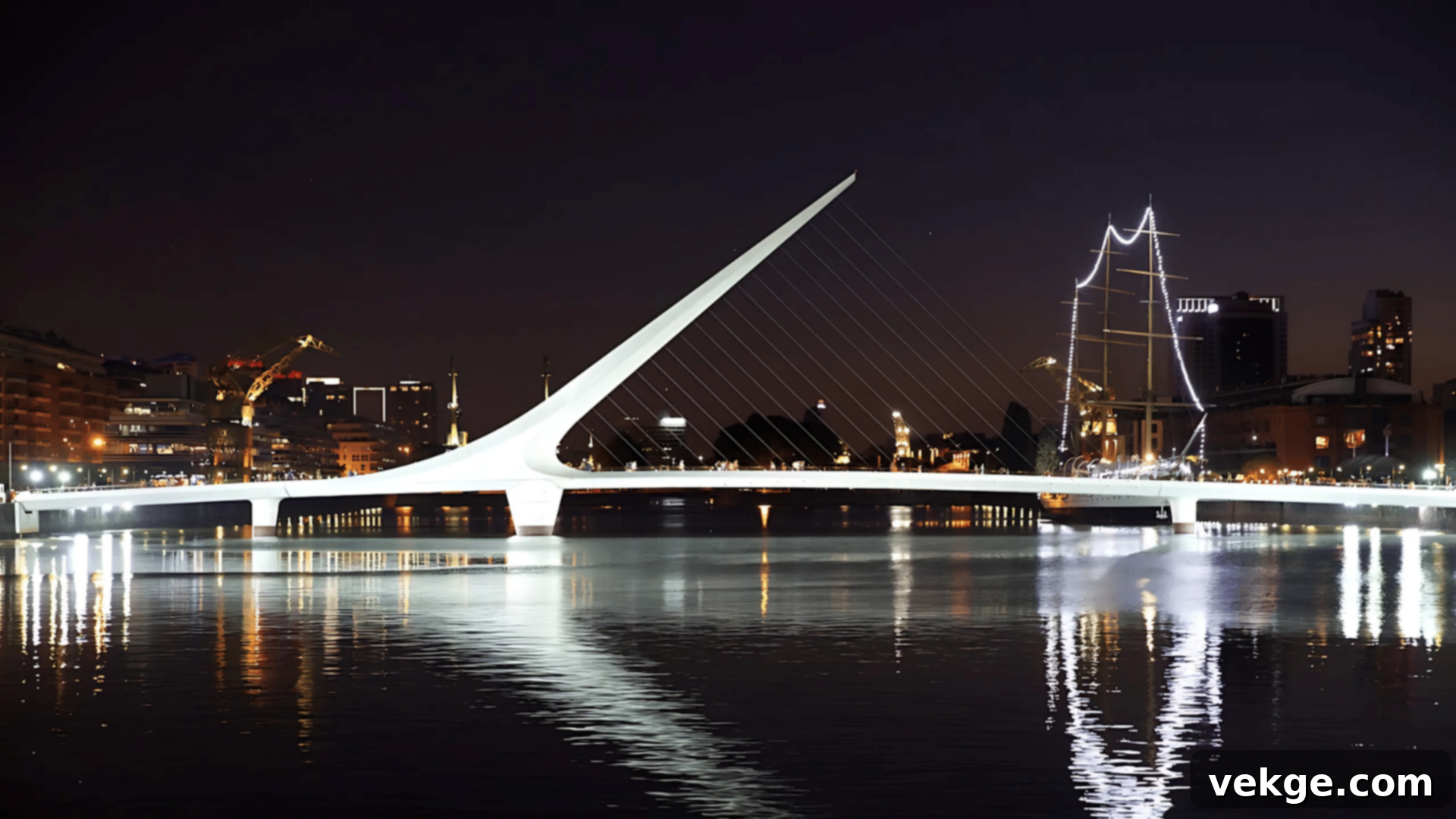
You’ll undoubtedly be captivated when walking across the Puente de la Mujer, a stunning and highly symbolic turning footbridge located in the revitalized Puerto Madero district of Buenos Aires. Designed by the internationally acclaimed Spanish architect Santiago Calatrava, this bridge is a true engineering and artistic marvel. Its unique, asymmetrical design features a single mast with cables supporting a rotating section that can pivot to allow boats to pass through, seamlessly blending useful function with breathtaking form.
The bridge’s elegant white form, made of steel, concrete, and wood, stands out dramatically against the water, creating fantastic photo opportunities, especially at sunset when its sleek lines catch the golden light. Many people interpret its design as an abstract representation of a couple dancing the tango, with the mast symbolizing the man and the curved deck representing the woman, thus linking the bridge intrinsically to Buenos Aires’ most famous dance. Named in honor of the numerous women who have contributed to Argentine history, culture, and society, the Puente de la Mujer is more than just a crossing; it’s a modern icon and a beloved symbol of the city’s innovative spirit and cultural heritage.
14. Teatro General San Martín

The Teatro General San Martín is a quintessential example of modernist Brutalist architecture that rose to prominence in the mid-20th century. This formidable, block-shaped concrete building, completed in 1960, houses not one but several theaters stacked on top of each other, making it a pivotal cultural complex in the heart of the city. As a major hub for performing arts, it consistently hosts a wide array of plays, contemporary dance performances, film screenings, and art exhibitions, and even includes a prestigious acting school.
The building’s design, characterized by its robust, unadorned concrete surfaces and strong geometric forms, deliberately prioritizes the functionality and artistic events happening inside over external ornamentation. Its monumental scale and utilitarian aesthetic reflect a modern philosophy that places emphasis on public access to culture and efficient design. The Teatro General San Martín stands as a beacon for the arts, a place where you can immerse yourself in all kinds of cultural expressions under one roof, from avant-garde cinema to live theatrical productions, making it a vital institution for Buenos Aires’ artistic community.
15. National Library of Argentina (Biblioteca Nacional)
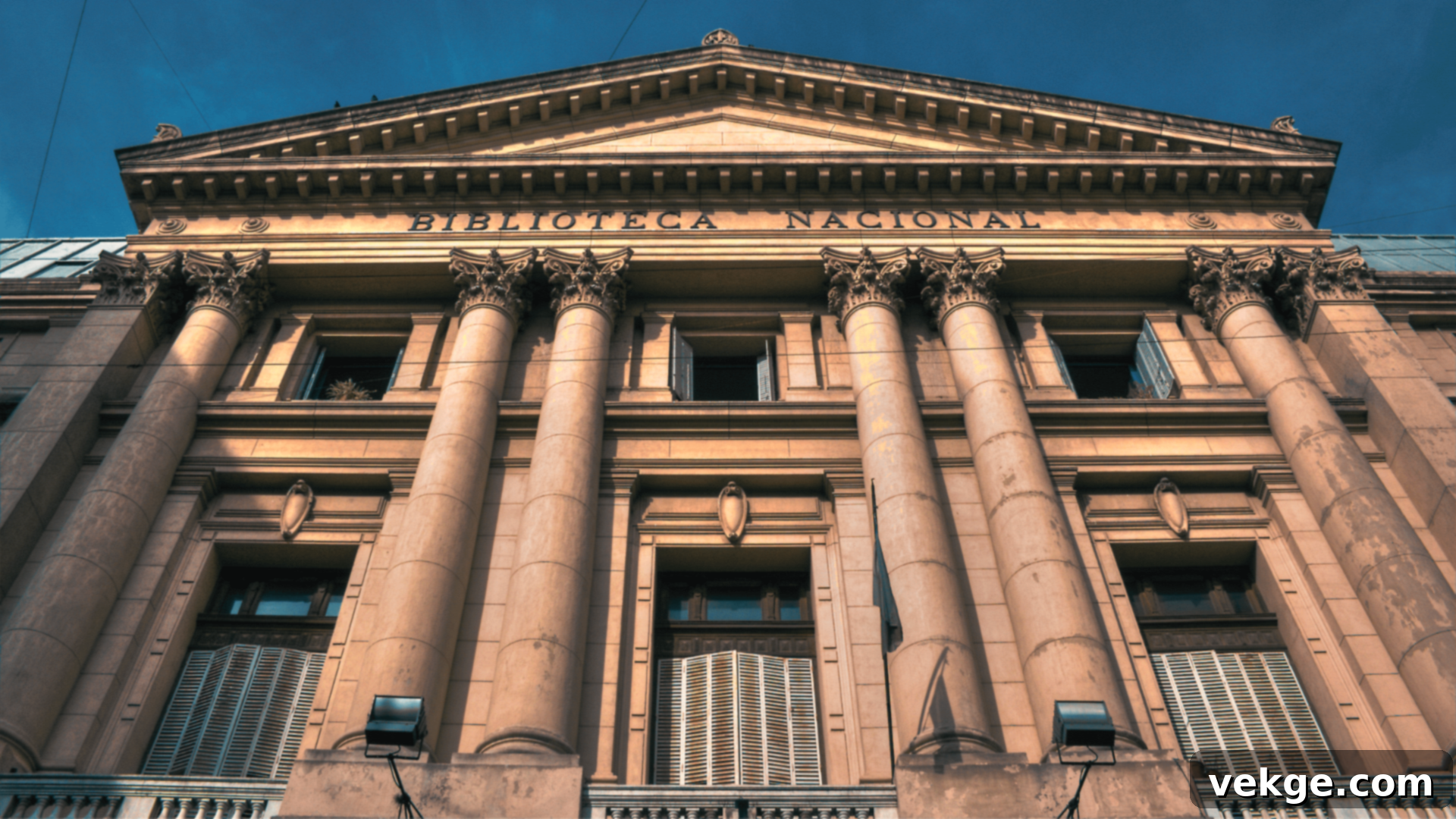
The National Library of Argentina, formally named the Biblioteca Nacional Mariano Moreno, is an architectural marvel and a significant example of Brutalist design, completed in 1992 after a lengthy construction period. Its distinctive and highly debated design features a massive concrete structure elevated on four monumental pillars, leaving a large portion of the ground level open. This clever design decision allows for the preservation of valuable public park space beneath the main building, creating a unique integration of urban green space and cultural institution.
Much of the library’s vast collection, including millions of books and documents, is housed in extensive, climate-controlled storage rooms located underground, protecting them from the elements. The visible upper part of the building, with its bold, futuristic, and somewhat imposing style, has been a subject of both admiration and criticism since its inception. While some praise its audacious vision and innovative approach to urban planning, others find its raw concrete aesthetic too stark. Regardless, the library stands as a powerful statement about combining intellectual heritage with modern architectural principles, offering a fascinating blend of nature and a repository of knowledge in the heart of the city.
Argentina’s Architectural Highlights by Style: A Diverse Tapestry
Buenos Aires is a living canvas where different architectural styles from across the centuries converge, creating an incredibly rich and diverse urban experience. As you navigate the city’s bustling streets, you’ll observe how external influences from Europe mixed with local tastes and needs to forge a unique aesthetic. Here’s a brief tour of the predominant building styles you can discover, each contributing a distinct thread to Argentina’s architectural tapestry.
European Influence and Belle Époque Grandeur
During the late 19th and early 20th centuries, Argentina’s booming economy and strong ties to Europe led to an architectural golden age, particularly in Buenos Aires. Buildings from this Belle Époque period exude opulence and a distinct European flair. Stepping into the Teatro Colón, for instance, instantly transports you to a grand old-world opera house with its ornate details, gilded halls, and a palpable sense of historical luxury. Similarly, the Paz Palace, once the largest private mansion in the city, with its imported materials and French Beaux-Arts design, offers a glimpse into the lavish lifestyle of Argentina’s elite who sought to emulate European aristocracy. Even the imaginative Palacio Barolo, while uniquely Argentine in its literary inspiration, borrows heavily from European Gothic and Romanesque architectural traditions to create its intricate symbolic narrative. These structures collectively highlight Buenos Aires’ profound connection to European aesthetic sensibilities and its ambition to be a world-class capital.
Nationalism and Symbolic Structures
As Argentina matured as a nation, its architecture began to embody a strong sense of national pride and symbolic representation. The Casa Rosada, the iconic pink presidential palace, immediately catches the eye and serves as the ultimate symbol of Argentine executive power and political history. Its unique color, as discussed, is steeped in tales of national unity. The Palace of the Argentine National Congress, with its majestic dome reminiscent of other world capitals, stands as a grand testament to the country’s democratic ideals and legislative power. Even the Torre Monumental, originally a gift from the British, has been redefined through a national lens, reflecting the country’s complex history and evolving identity. These buildings were deliberately crafted to inspire awe and convey the growing strength and self-awareness of the Argentine nation.
Modern Engineering and Urban Innovation
The 20th century saw Argentina embrace modernism, bringing forth designs that prioritized functionality, innovative materials, and bold structural statements. The Kavanagh Building, for example, was a marvel of its time, breaking records as one of the world’s tallest reinforced concrete buildings in 1936, showcasing pioneering engineering. The National Library of Argentina, with its massive concrete volume elevated on monumental pillars, exemplifies modern planning by preserving public green space below—a bold and often discussed design choice. Buildings like the Teatro General San Martín, with its Brutalist aesthetic, focus on creating multi-functional cultural spaces. These newer architectural expressions demonstrate how Buenos Aires continuously explores new ideas in urban planning and design, pushing boundaries and defining its contemporary skyline with a confident, forward-looking vision.
Unique and Colorful Architecture: The Soul of Local Communities
Beyond the grand palaces and modern skyscrapers, Buenos Aires also boasts pockets of extraordinary charm and vibrant color, born from the heart of its local communities. These unique architectural expressions, often spontaneous and deeply personal, reveal a fun, creative, and profoundly authentic side of the city, showing how everyday people contribute to its captivating visual identity.
La Boca Neighborhood’s Caminito Street
Walking down Caminito Street in the historic La Boca neighborhood is an utterly immersive experience, akin to stepping directly into a vivid, exuberant painting! The homes here are an explosion of bright blues, sunshine yellows, fiery reds, and emerald greens, creating a kaleidoscope of color that is sure to make any visitor smile. This unique tradition of brightly painted houses originated from the district’s working-class roots, particularly among the Italian immigrants who settled here. Dock workers, short on money but rich in creativity, would use leftover boat paint to adorn their humble corrugated iron houses, resulting in the iconic patchwork of vibrant hues seen today.
Caminito is not just visually stunning; it’s a lively cultural hotspot where you can feel the neighborhood’s strong Italian and immigrant heritage, inextricably linked with the birth of tango. Street artists, tango dancers, and local vendors fill the narrow pedestrian street, creating an unforgettable atmosphere. It’s a testament to how humble origins can give rise to one of the most recognizable and beloved architectural expressions in Buenos Aires.
Painted Homes and Street Art Influence
The infectious spirit of the colorful houses in La Boca has had a lasting impact, inspiring artists and residents across Buenos Aires. This influence is palpable in the city’s thriving street art scene, where vibrant murals and painted walls adorn buildings in various neighborhoods, transforming ordinary urban spaces into public art galleries. These works often tell compelling stories of local life, social issues, and cultural heritage, adding layers of meaning and beauty to the cityscape. From elaborate multi-story murals to simple splashes of color on a residential facade, these painted places demonstrate how regular people, local artists, and community initiatives, not just famous architects, actively shape and enrich the visual character of the city. This grassroots artistry ensures that Buenos Aires remains dynamic, colorful, and ever-evolving, always with a new visual story waiting to be discovered around the next corner.
Conclusion: Argentina’s Enduring Architectural Narrative
From the solemn grandeur of its old colonial buildings to the playful exuberance of its brightly colored homes, Buenos Aires’s architecture presents a multifaceted and compelling narrative of Argentina’s past and present. As we have explored throughout this journey, the city doesn’t merely replicate styles from other places; rather, it absorbs, adapts, and infuses them with its own unique twist, creating an identity that is both globally influenced and distinctly Argentine.
The remarkable blend of European grandeur, evident in its Belle Époque palaces and neoclassical cathedrals, sits harmoniously alongside powerful national symbols like the Casa Rosada, which tell tales of political struggle and unity. This richness is further enhanced by groundbreaking modern designs that showcase engineering prowess and a forward-thinking vision, seamlessly integrated with the organic, community-driven artistry seen in the vibrant streets of La Boca. This incredible fusion of history, culture, and innovation makes Buenos Aires truly one of a kind, a city where every building has a story waiting to be told.
The next time you find yourself strolling through the dynamic streets of Buenos Aires, take a moment. Pause, look up, and truly observe these magnificent structures. Think about the indigenous hands that helped build the Jesuit missions, the dock workers who painted their homes with leftover boat paint, or the visionary architect who transformed Dante’s epic poem into a towering masterpiece. Each structure is more than just stone, concrete, or tile; it is a vital chapter in Argentina’s enduring and captivating story, inviting you to delve deeper into its soul.
